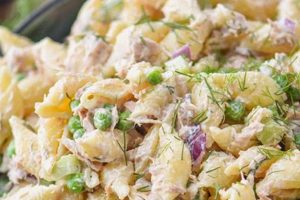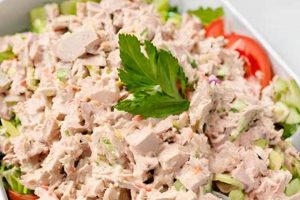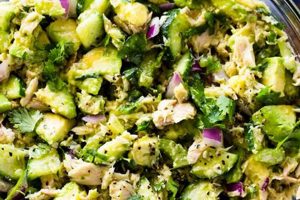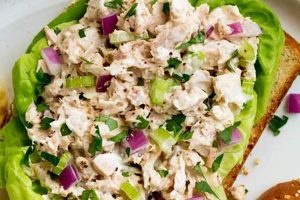A nutritious and flavorful tuna salad typically involves lean protein from tuna, combined with healthy fats and other wholesome ingredients. For example, instead of mayonnaise, Greek yogurt or avocado can provide creaminess while boosting nutritional value. Incorporating fresh vegetables like celery, red onion, and bell peppers adds fiber, vitamins, and satisfying crunch. Emphasis is placed on minimizing processed ingredients and maximizing flavor through fresh herbs, spices, and citrus.
Such a salad offers numerous health benefits. Tuna is rich in omega-3 fatty acids, crucial for heart health and brain function. Opting for healthier ingredients contributes to weight management, improved digestion, and increased micronutrient intake. This approach to meal preparation aligns with contemporary dietary guidelines that prioritize whole foods and balanced nutrition. Historically, tuna salad has relied heavily on mayonnaise, but evolving health consciousness has led to innovative and healthier variations.
This discussion will further explore specific ingredients, preparation methods, and variations to achieve a delicious and nutritious tuna salad. Topics covered will include ingredient selection, portion control, and potential recipe adaptations for various dietary needs and preferences.
Tips for a Healthy and Delicious Tuna Salad
Creating a nutritious and flavorful tuna salad involves careful ingredient selection and thoughtful preparation. These tips offer guidance on maximizing both health benefits and taste.
Tip 1: Choose tuna packed in water. Tuna packed in water significantly reduces overall fat and calorie content compared to oil-packed varieties.
Tip 2: Opt for plain Greek yogurt instead of mayonnaise. Greek yogurt provides a creamy texture similar to mayonnaise but with added protein and probiotics, contributing to gut health. A small amount of olive oil can be incorporated for richness.
Tip 3: Incorporate a variety of fresh vegetables. Chopped celery, red onion, bell peppers, and carrots add flavor, texture, and essential vitamins and fiber.
Tip 4: Enhance flavor with fresh herbs and spices. Dill, parsley, chives, and a dash of black pepper can elevate the taste without relying on excess salt or processed seasonings.
Tip 5: Utilize avocado for creaminess and healthy fats. Mashed avocado contributes healthy monounsaturated fats and a rich, satisfying texture.
Tip 6: Consider adding a squeeze of lemon or lime juice. Citrus juice brightens the flavor profile and provides a touch of acidity that complements the other ingredients.
Tip 7: Control portion sizes. Even healthy ingredients should be consumed in moderation for balanced nutrition and weight management.
By following these tips, one can create a tuna salad that is both healthy and delicious. This approach supports overall wellness by incorporating nutrient-rich ingredients and minimizing processed components.
These practical tips offer a foundation for crafting a personalized tuna salad recipe. The following section will provide concluding remarks and further resources for healthy eating.
1. High-quality Tuna
High-quality tuna plays a crucial role in a healthy and flavorful tuna salad. The type and quality of tuna significantly impact the overall nutritional profile, taste, and texture of the final dish. Understanding the characteristics of high-quality tuna enables informed choices that contribute to a superior culinary outcome.
- Species and Sourcing
Different tuna species possess varying flavor profiles, textures, and levels of mercury. Albacore and skipjack are commonly used in tuna salad. Skipjack typically has lower mercury levels. Sourcing from sustainable fisheries ensures responsible fishing practices and helps maintain healthy ocean ecosystems. Choosing tuna caught using sustainable methods contributes to environmental responsibility.
- Processing Method
Tuna is available canned, pouched, or fresh. For tuna salad, canned or pouched tuna is most practical. Opting for tuna packed in water rather than oil reduces overall fat and calorie content. Solid or chunk light tuna offers larger pieces, while flaked tuna provides a finer texture.
- Nutritional Value
Tuna is a rich source of lean protein and omega-3 fatty acids, essential for heart health and brain function. High-quality tuna provides these crucial nutrients with minimal saturated fat. Checking labels for sodium content helps manage overall dietary intake.
- Sensory Characteristics
High-quality tuna exhibits a firm texture and a fresh, clean aroma. It should be free from off-flavors or discoloration. These sensory characteristics contribute to a more palatable and enjoyable tuna salad experience. The appearance and aroma of the tuna directly influence the final dish’s appeal.
By prioritizing these factors, one can select high-quality tuna that enhances the nutritional value and flavor of a healthy tuna salad. Choosing tuna packed in water, from sustainable sources, and with desirable sensory characteristics ensures a healthier and more flavorful final product. This emphasis on quality ingredients contributes significantly to a truly “best” tuna salad recipe, both in terms of health and taste.
2. Reduced Fat
Reduced fat content is a cornerstone of a healthy tuna salad recipe. Traditional recipes often rely heavily on mayonnaise, contributing significant saturated fat and calories. This added fat detracts from the health benefits of the lean protein in tuna. Reducing fat content allows the nutritional value of the tuna to take center stage, aligning with dietary guidelines that emphasize lean protein sources and minimize saturated fat intake. For example, substituting Greek yogurt or mashed avocado for mayonnaise drastically reduces fat while adding protein, beneficial fats, and other nutrients. This substitution exemplifies how reducing fat can enhance a recipe’s nutritional profile without sacrificing flavor or texture.
The impact of reduced fat extends beyond calorie control. Lowering saturated fat intake contributes to improved cardiovascular health and can aid in weight management. A lower-fat tuna salad also allows for the incorporation of other healthy fats, such as those found in olive oil or avocado, which offer additional health benefits. For instance, a tuna salad dressed with a small amount of olive oil and lemon juice provides heart-healthy monounsaturated fats and a vibrant flavor profile. This approach demonstrates how reducing one type of fat creates space for healthier alternatives, maximizing nutritional benefits.
Prioritizing reduced fat in a tuna salad recipe reflects a commitment to health-conscious eating. It demonstrates an understanding of the impact of dietary fat on overall well-being. This principle aligns with broader dietary trends that emphasize whole foods and balanced nutrition. While flavor and satisfaction remain important, a truly “best” tuna salad recipe acknowledges the crucial role of reduced fat in achieving a healthy and delicious meal. The practical application of this understanding empowers individuals to make informed choices that support their health goals.
3. Fresh Ingredients
Fresh ingredients are fundamental to a “best tuna salad recipe healthy.” They contribute significantly to both the flavor profile and nutritional value, distinguishing a truly superior salad from a mediocre one. The emphasis on freshness aligns with broader dietary trends that prioritize whole, unprocessed foods for optimal health and well-being. This section explores the multifaceted role of fresh ingredients in creating a healthy and delicious tuna salad.
- Vegetables
Fresh vegetables provide crucial vitamins, minerals, and dietary fiber, enhancing the nutritional value of tuna salad. Crisp celery, red onion, and bell peppers add textural complexity and vibrant flavors. For example, the crunch of diced celery complements the softness of the tuna, while red onion offers a subtle bite. These additions create a more satisfying and nutrient-rich meal compared to salads relying solely on processed ingredients.
- Herbs
Fresh herbs elevate the flavor profile of tuna salad without relying on excess salt or artificial seasonings. Dill, parsley, chives, and cilantro offer distinct aromatic notes that complement the tuna. Fresh dill, for instance, provides a bright, slightly tangy flavor that balances the richness of the tuna. The use of fresh herbs aligns with health-conscious cooking practices that prioritize natural flavor enhancers.
- Citrus
A squeeze of fresh lemon or lime juice brightens the flavor of tuna salad, adding a touch of acidity that balances the other ingredients. Citrus juice also acts as a natural preservative, extending the shelf life of the salad. Freshly squeezed lemon juice, in particular, provides a vibrant citrus note that cuts through the richness of the tuna and other ingredients. This addition contributes to a more complex and refreshing flavor profile.
- Avocado
Fresh avocado contributes healthy monounsaturated fats, creamy texture, and a mild, buttery flavor to tuna salad. It serves as a healthier alternative to mayonnaise, reducing saturated fat content while adding nutritional value. The creamy texture of mashed avocado binds the salad ingredients together, enhancing the overall mouthfeel. This addition aligns with health-conscious eating patterns that prioritize healthy fats and whole foods.
The incorporation of these fresh ingredients elevates a tuna salad from simple to exceptional. They contribute not only to enhanced flavor and texture but also to improved nutritional value. This emphasis on freshness underscores the connection between a “best tuna salad recipe healthy” and the quality of its ingredients. The synergistic interplay of fresh vegetables, herbs, citrus, and avocado creates a truly delicious and health-conscious meal.
4. Balanced Flavor Profile
A balanced flavor profile is integral to a “best tuna salad recipe healthy.” It ensures palatability and encourages mindful consumption, contributing to overall dietary adherence and satisfaction. A balanced profile avoids over-reliance on any single flavor, preventing sensations of overwhelming richness, excessive saltiness, or pronounced sweetness. This balance allows the inherent flavors of the quality ingredients, such as fresh tuna, vegetables, and herbs, to shine. For example, the slight tanginess of Greek yogurt complements the richness of tuna, while the crunch of celery and red onion provides textural contrast. This interplay of flavors and textures creates a more enjoyable and satisfying eating experience, crucial for maintaining long-term healthy eating habits. A harmonious blend of flavors also reduces the temptation to add excessive salt or unhealthy condiments, further supporting health goals. The absence of a balanced profile can lead to dissatisfaction and the potential for overconsumption of less healthy options.
Achieving a balanced flavor profile requires careful consideration of ingredient combinations and proportions. The delicate flavor of tuna can be easily overwhelmed by strong ingredients. Therefore, moderation is key. A touch of acidity from lemon juice or vinegar brightens the flavor and balances the richness of the tuna and any added fats. Fresh herbs, such as dill or parsley, provide subtle aromatic notes that complement the tuna without overpowering it. Spices, used judiciously, add complexity and depth. For instance, a pinch of black pepper enhances the overall flavor profile without excessive sodium. Careful attention to these details ensures that each ingredient contributes to a harmonious whole, maximizing enjoyment and promoting healthy eating habits. The strategic use of contrasting flavors and textures keeps the palate engaged, fostering a more mindful and satisfying meal experience.
A balanced flavor profile distinguishes a truly exceptional tuna salad from a merely adequate one. It signifies a thoughtful approach to recipe development, prioritizing both health and enjoyment. This principle extends beyond individual recipes to encompass a broader understanding of balanced nutrition and its role in overall well-being. By understanding the significance of a balanced flavor profile, individuals can make informed choices that support their health goals while savoring delicious and satisfying meals. The pursuit of a balanced flavor profile ultimately enhances the long-term sustainability of healthy eating patterns.
5. Ample Protein
Ample protein is a critical component of a “best tuna salad recipe healthy,” directly influencing satiety, metabolic function, and the overall nutritional value of the meal. Protein plays a crucial role in supporting muscle mass, tissue repair, and various other physiological processes. Within the context of a healthy tuna salad, prioritizing ample protein content contributes to a more satisfying and nutrient-rich meal that aligns with health-conscious dietary guidelines. This section explores the multifaceted benefits and implications of ample protein in a healthy tuna salad.
- Satiety and Appetite Regulation
Protein promotes satiety, the feeling of fullness after a meal, more effectively than carbohydrates or fats. This enhanced satiety helps regulate appetite and potentially contributes to weight management by reducing overall calorie intake. In a tuna salad, ample protein content helps curb hunger and prevent overeating, supporting healthy portion control and contributing to long-term dietary adherence. For example, a tuna salad rich in protein is more likely to keep an individual feeling full and satisfied until their next meal, reducing the likelihood of unhealthy snacking.
- Metabolic Function and Muscle Mass
Protein provides essential amino acids necessary for building and maintaining muscle mass. Adequate protein intake supports metabolic function and helps preserve lean muscle tissue, particularly important during periods of calorie restriction or increased physical activity. In a healthy tuna salad, ample protein contributes to these metabolic processes, supporting overall physical well-being. For individuals engaged in regular exercise, a protein-rich tuna salad can assist in muscle recovery and growth.
- Nutrient Density and Overall Health
Prioritizing protein in a tuna salad contributes to overall nutrient density, maximizing the nutritional benefits per calorie consumed. Protein-rich foods often contain other essential nutrients, such as iron and B vitamins. In a healthy tuna salad, ample protein helps ensure that the meal provides a wide range of essential nutrients, contributing to overall health and well-being. This focus on nutrient density aligns with dietary guidelines that emphasize nutrient-rich foods for optimal health.
- Recipe Versatility and Ingredient Compatibility
Tuna’s inherent protein content allows for recipe versatility and ingredient compatibility. The inclusion of other protein-rich ingredients, such as beans, lentils, or hard-boiled eggs, further enhances the protein content and offers textural variety. These additions create opportunities for customized recipes catering to individual dietary needs and preferences. For example, adding chickpeas to a tuna salad introduces plant-based protein and fiber, creating a more complete and balanced meal. This adaptability makes a protein-rich tuna salad a versatile option for various dietary patterns.
Ample protein content is a defining characteristic of a “best tuna salad recipe healthy.” It contributes to satiety, supports metabolic function, enhances nutrient density, and offers recipe versatility. Prioritizing protein maximizes the nutritional benefits of this versatile dish, aligning with health-conscious dietary principles and contributing to a satisfying and nutritious meal that supports overall well-being. By understanding the multifaceted role of protein, individuals can make informed choices that enhance the healthfulness and enjoyment of their tuna salad.
6. Controlled Sodium
Controlled sodium content is paramount in a “best tuna salad recipe healthy.” Excessive sodium intake is linked to adverse health outcomes, including hypertension and cardiovascular disease. Therefore, minimizing sodium in a tuna salad contributes significantly to its healthfulness. Canned tuna, a primary ingredient, can be a significant source of sodium. Opting for lower-sodium varieties or rinsing canned tuna under cold water before use can substantially reduce sodium content. Additionally, minimizing added salt during preparation and using fresh herbs, spices, and citrus juices for flavor instead of high-sodium seasonings or condiments further controls sodium levels. For example, instead of relying on salty pickles or olives for flavor, incorporating fresh dill, lemon juice, and black pepper achieves a flavorful profile without compromising sodium content. This approach demonstrates how ingredient selection and mindful preparation can effectively control sodium levels without sacrificing taste.
The practical significance of controlling sodium extends beyond immediate health benefits. A lower-sodium tuna salad allows for greater flexibility in meal planning and complements other dietary strategies aimed at reducing overall sodium intake. For instance, a low-sodium tuna salad pairs well with whole-grain bread or crackers, creating a balanced and health-conscious meal. Conversely, a high-sodium tuna salad might necessitate limiting sodium intake from other foods throughout the day, restricting dietary choices. Furthermore, controlling sodium in a tuna salad instills healthy cooking habits that can be applied to other recipes and meal preparations, promoting long-term dietary wellness. This approach emphasizes the interconnectedness of individual recipe components with broader dietary patterns.
In conclusion, controlled sodium content is an essential aspect of a truly “best tuna salad recipe healthy.” It reflects an understanding of the impact of dietary sodium on overall health and demonstrates a commitment to health-conscious cooking practices. By meticulously managing sodium levels through ingredient selection and mindful preparation, individuals can create a delicious and nutritious tuna salad that supports both immediate and long-term well-being. This principle underscores the importance of considering the nutritional implications of every ingredient and preparation method, emphasizing the holistic nature of healthy eating.
7. Nutrient-dense additions
Nutrient-dense additions elevate a basic tuna salad to a “best tuna salad recipe healthy,” transforming it into a powerhouse of nutritional value. These additions contribute significantly to overall health and well-being by providing essential vitamins, minerals, antioxidants, and healthy fats. They complement the lean protein from tuna, creating a more balanced and complete meal. Strategic incorporation of nutrient-dense ingredients maximizes the health benefits of the salad, aligning with dietary guidelines that emphasize nutrient-rich foods.
- Nuts and Seeds
Nuts and seeds, such as walnuts, almonds, or sunflower seeds, provide healthy fats, fiber, and essential micronutrients. Walnuts, for example, offer omega-3 fatty acids and antioxidants, contributing to heart health and reducing inflammation. These additions enhance the nutritional profile of the salad while adding satisfying texture and flavor. A small handful of chopped walnuts complements the tuna and other ingredients, creating a more complex and nutritious meal.
- Legumes
Legumes, such as chickpeas or lentils, offer plant-based protein and fiber, enhancing satiety and promoting digestive health. Chickpeas, for instance, provide a good source of iron and folate, essential nutrients for various bodily functions. Incorporating legumes diversifies the protein sources in the salad and adds a satisfying texture. A half-cup of chickpeas complements the tuna, creating a more balanced and nutrient-rich meal.
- Dried Fruits
Dried fruits, such as cranberries or chopped apricots, offer a touch of natural sweetness and contribute essential vitamins and minerals. Cranberries, for example, are rich in antioxidants and may support urinary tract health. These additions provide a flavor contrast to the savory elements of the salad. A small amount of dried cranberries complements the other ingredients, adding a touch of sweetness and enhancing the nutritional profile.
- Cruciferous Vegetables
Cruciferous vegetables, such as shredded broccoli or chopped cauliflower, offer a wealth of vitamins, minerals, and antioxidants. Broccoli, for instance, is a good source of vitamin C and fiber, supporting immune function and digestive health. These additions increase the nutrient density of the salad while adding textural complexity. Finely chopped broccoli or cauliflower blends seamlessly with the other ingredients, creating a more nutritious and flavorful meal.
These nutrient-dense additions transform a simple tuna salad into a powerhouse of nutritional value. They contribute essential vitamins, minerals, antioxidants, and healthy fats, aligning with dietary guidelines that emphasize nutrient-rich foods. By strategically incorporating these ingredients, individuals can maximize the health benefits and enjoyment of their tuna salad, contributing to a more balanced and health-conscious diet. These additions not only enhance the nutritional profile but also offer diverse flavors and textures, creating a more satisfying and enjoyable meal experience. This comprehensive approach to ingredient selection demonstrates the interconnectedness of flavor, nutrition, and overall well-being in a “best tuna salad recipe healthy.”
Frequently Asked Questions
This section addresses common inquiries regarding the creation of a healthy and delicious tuna salad, clarifying potential misconceptions and offering practical guidance.
Question 1: How can canned tuna be incorporated into a healthy diet?
Canned tuna, packed in water, offers a convenient and affordable source of lean protein and omega-3 fatty acids. Opting for lower-sodium varieties or rinsing the tuna before use minimizes sodium intake. Incorporating canned tuna into a salad with fresh vegetables, whole grains, and healthy fats creates a balanced and nutritious meal.
Question 2: What are healthier alternatives to mayonnaise in tuna salad?
Plain Greek yogurt, mashed avocado, or a combination of the two offer healthier alternatives to mayonnaise, reducing saturated fat while adding beneficial nutrients and creamy texture. A small amount of olive oil can be incorporated for added richness and flavor.
Question 3: How can sodium content be minimized in tuna salad?
Choosing lower-sodium canned tuna, rinsing the tuna before use, and avoiding added salt during preparation significantly reduce sodium content. Utilizing fresh herbs, spices, and citrus juices for flavor instead of high-sodium seasonings or condiments further minimizes sodium intake.
Question 4: What are some nutrient-dense additions to enhance the nutritional value of tuna salad?
Chopped nuts, seeds, legumes, chopped cruciferous vegetables, and a small amount of dried fruit enhance the nutritional profile of tuna salad by providing healthy fats, fiber, vitamins, minerals, and antioxidants. These additions contribute to a more balanced and complete meal.
Question 5: How can tuna salad be incorporated into a weight-management plan?
Tuna salad, prepared with healthy ingredients and portioned appropriately, can be a valuable component of a weight-management plan. The high protein content promotes satiety, while the inclusion of fresh vegetables and healthy fats increases nutrient density and supports overall health.
Question 6: How can one ensure food safety when preparing tuna salad?
Proper refrigeration of ingredients and the finished salad is crucial for food safety. Perishable ingredients should be kept chilled until used, and the prepared salad should be refrigerated promptly. Consuming the salad within a few days of preparation minimizes the risk of bacterial growth.
Prioritizing ingredient quality, balanced nutrition, and mindful preparation ensures a tuna salad that contributes to overall health and well-being.
The following section will provide a sample recipe incorporating these principles.
Best Tuna Salad Recipe Healthy
Exploration of a “best tuna salad recipe healthy” reveals the critical interplay of ingredient quality, mindful preparation, and balanced nutrition. Prioritizing lean protein from high-quality tuna, minimizing saturated fat through judicious ingredient selection, and incorporating nutrient-dense additions such as fresh vegetables, herbs, and healthy fats optimizes both flavor and nutritional value. Controlled sodium content further contributes to the recipe’s healthfulness, aligning with dietary guidelines that emphasize sodium reduction for overall well-being. The synthesis of these elements yields a culinary creation that transcends mere sustenance, representing a conscious choice to prioritize health without compromising enjoyment.
A “best tuna salad recipe healthy” signifies more than a simple culinary formula; it embodies a commitment to informed dietary choices and their profound impact on overall health and well-being. This approach empowers individuals to transform a commonplace dish into a vehicle for balanced nutrition, promoting a healthier and more fulfilling lifestyle. Continued exploration of culinary possibilities through the lens of nutritional awareness promises further evolution of classic recipes, inspiring a future where healthy eating is synonymous with delicious and satisfying meals.






